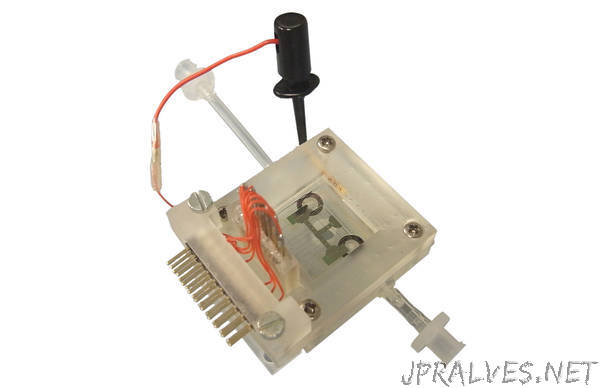
“An important aspect of pharmacology is understanding how active drug ingredients cross-react with endogenous molecules. But until now, such reactions could only be determined after the event. The precise details of the interacting factors remained unclear. Fraunhofer researchers have developed a new technology that enables biochemical reactions to be monitored from start to finish at the single-molecule level.
All that is needed to perform such tests are tiny sample droplets of the reagent solution – so tiny that they are barely visible to the naked eye. The droplets change shape when an electric voltage is applied, allowing them to be pulled apart, moved in different directions, or split into separate molecules. The underlying physical phenomenon is referred to as electrowetting. The application of an electric field changes the distribution of electric charges in the droplets, enabling them to be manipulated individually.
Electrowetting also enables two different sample droplets to be merged into one. “The ingenious feature of our system is that for the first time we can observe the details of how the two droplets interact at the single-molecule level – thus allowing us to monitor the entire chain of events,” says Lorenz Sparrenberg from the Fraunhofer Institute for Applied Information Technology FIT, who is leading the research project.
Deep insights provided by confocal microscopy
The electrowetting system developed by Sparrenberg and his team consists of an array of electrodes on a chip, hence the name electrowetting-on-dielectric (EWOD) system. Depending on the switching state of the electrodes, the droplets can be manipulated to move further apart or closer together, and be brought together to merge in a predefined spot. This process is monitored using a confocal microscope, enabling high-resolution measurements to be recorded. “By combining electrowetting with confocal microscopy, we can study biological interactions under conditions closely resembling those that occur naturally in the human body. In pharmacology, for example, is important to understand the effects of drug ingredients as precisely as possible and know when these effects occur.”
Conventional laboratory tests not only deliver less information but also require much higher quantities of the sample liquids, and take longer to perform. The typical duration of an enzymatic assay, for example, is around 15-20 minutes. “With our system, the results can be available within 30 seconds.” The combination of EWOD and confocal microscopy could also be used to study the interaction between complementary DNA strands, antibodies and antigens, or enzyme-substrate reactions – the possibilities are endless.
Predestined for point-of-care diagnostics
These advantages predestine the system for use in point-of-care diagnostics, in other words tests that can be carried out at the bedside in hospitals or in the physician’s office, instead of sending samples to a central laboratory. Such pocket-sized lab-on-a-chip solutions would be able to deliver results of blood or urine tests in next to no time without complicated procedures.
“Until now, we have concentrated on proof-of-concept, demonstrating that the combination of our EWOD device with confocal microscopy is capable of providing information at the single-molecule level. We are now looking for industry partners to help us develop concrete applications,” says Sparrenberg.
The system will be presented at the MEDICA trade fair in Düsseldorf, which takes place from November 13 to 16 (joint Fraunhofer booth in Hall 10, Booth 10 G05 / H04).”
